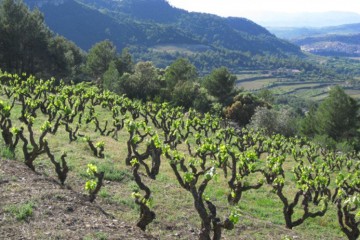The Finger Lakes Region: finding a way beyond the wine trail
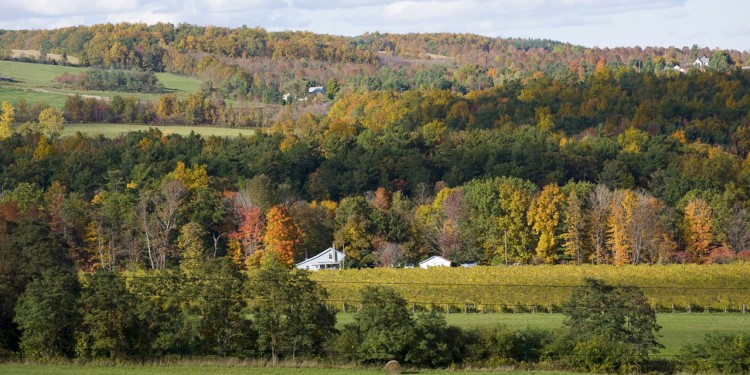
Appearing in Gilbert & Gaillard International, Summer 2013
The Finger Lakes can be counted among the greatest wine regions in the world. Or has the potential to be. It’s a bold statement and one that, for the next few years, needs a few qualifications. But, with a distinct geology, geography and conditions that ‘cool climate’ grapes seem to favor, and thoughtful, outward-looking winemakers, it is not folly to imagine that the Finger Lakes is on its way to becoming one of the most respected wine
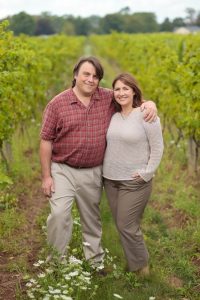
regions in the United States and, therefore, the world. As Morten Halgren, winemaker at Ravines Wine Cellars, which he owns with wife Lisa, sums it up: “It’s a region where you can work with both [superb] Riesling and Pinot Noir, the most expressive of grape varieties. What more can a winemaker want?”
Skeptical? Just have a sip of one of Halgren’s Rieslings. (Or, one by Bloomer Creek, Anthony Road, Hermann J. Wiemer, Red Newt, etc, etc).
It surprises many, even New Yorkers, to learn that, until 2000, New York State was second only to California in US wine production (it is now third, after Washington State). The greater portion of this wine came from the Finger Lakes region, an area in upstate New York, 360 kilometers northwest of New York City. Defined by 11 long and narrow glacier- formed lakes, the Finger Lakes region has been an important, if improbable wine growing region since the 19th century. The great majority of wine production takes place around four of the larger lakes: Keuka, Seneca, Cayuga, and Canandaigua, large bodies of water that moderate the worst effects of upstate New York’s very cold winters, when mid-January temperatures average between -1°C and -9°C . Summers are typically hot and humid, but there can be cool, rainy spells, too. In all, these are not ideal conditions to easily grow fine wine grapes of the vinifera species but quite suitable for native Vitis labrusca, as well as hybrids of American and European grape varieties. Though indigenous grapes offer flavors out of line with the tastes of most contemporary connoisseurs, a Finger Lakes sparkler made from native Catawba grapes captured a gold medal at the Vienna Exposition of 1873.
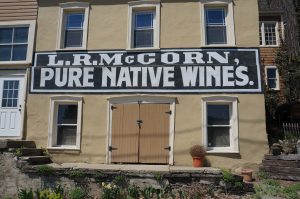
SLOW CONVERSION TO VINIFERA VARIETIES
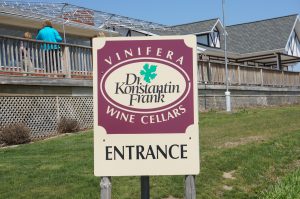
Dr Konstantin Frank: Where the vinifera revolution began on Keuka Lake.
Until the early 1950s, few were confident that any vinifera vine could survive winters in the Finger Lakes. Chief among the naysayers were the scientists at Cornell University’s Agricultural Experiment Station in the town of Geneva, located at the north tip of Seneca Lake. Their contention was challenged by Dr. Konstantin Frank, an ethnic-German, Soviet immigrant viticulturalist, who arrived in the Finger Lakes in 1953. His experience in the Ukraine, with winter conditions far harsher than in the Finger Lakes, convinced him that vinifera could thrive in the region, provided one used the right rootstocks and utilized appropriate practices. He was able to test his beliefs after meeting Charles Fournier, a former Veuve Clicquot winemaker who was president of Gold Seal winery, at the time one of the Finger Lakes’ most important producers. Fournier put Frank in charge of viticulture and allowed him to plant vinifera vines. By the end of the decade, it was clear that the experiment was successful. Fournier converted a portion of Gold Seal’s hybrid vineyards to vinifera and Frank established his own vinifera vineyards above the western shores of Keuka Lake. When he released his first wines in 1962, he proclaimed his vision through the name he gave the company; Dr. Konstantin Frank Vinifera Wine Cellars. The winery, currently headed by Dr. Frank’s grandson, Fred, celebrated its fiftieth anniversary last year.
Praised by critics, one could not deny Dr. Frank’s success as a viticulturalist and winemaker, but the conversion to vinifera in the region has been slower than one might expect. Of the 3,500 hectares planted to vines today, (compared to 10,000 ha a century ago], less than one quarter are vinifera. Until now, growers who sold grapes to large wineries making anonymous, ‘popular’ blends have been happy with the ease of growing winter and disease-resistant hybrids and natives. Furthermore, hybrid or native varietal wines are popular with locals and tourists drop into winery tasting rooms while they enjoy the region’s beauty. And, finally, if made with care, hybrid wines can be charming. Steve DiFrancesco, who makes both vinifera and hybrid wine at Glenora Cellars, points out, “Some hybrids, like Seyval, Vignoles and Traminette, have more character and flavor than common viniferas like [French] Colombard and Trebbiano. Hybrid doesn’t have to mean inferior.” Still, with a ton of Riesling commanding as much as five times the price of many hybrids, the future is very much in favor of vinifera.
THE FINEST RIESLING REGION IN THE US
No grape in the Finger Lakes attracts as much attention as Riesling. With 400 ha in production, it is the second most- planted grape of the region’s 140 varieties (the first is the pungent native. Concord, at 735 ha), and there is a rush to plant more. Today, it is rare that a winery doesn’t offer at least one Riesling. While not every one of them is stellar, 1 would argue that Finger Lakes is the finest Riesling region in the United States and, perhaps anywhere outside of Europe. Riesling loves mineral-rich soil and the region is awash with shale or limestone. Moreover, Riesling in the Finger Lakes has the tendency to achieve phenolic, or flavor, ripeness ahead of sugar ripeness. Since a grape’s acidity tends to lower as sugar levels rise, earlier flavor ripeness can ensure that full-flavored grapes will still have mouthwatering levels of acidity while sugar levels are still modest. Several winemakers in the Finger Lakes proudly report that they can pick their Riesling under 20 Brix of sugar (about 11 Baumé), allowing them to produce crisp, aromatic wines that are relatively low in alcohol. Of course, many winemakers also pick their grapes a bit riper to produce more powerful wines, but it is rare to find a Finger Lakes Riesling that measures over 12.5% alcohol. Styles range from bone dry to unctuously sweet, though the tendency is toward wines that are off-dry, high in acidity, with pHs typically at 3 or less. Whatever the style, there is a certain purity to the wines, fruit, minerality and acidity with little showiness.
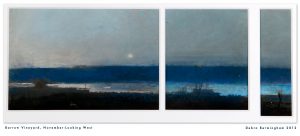
Finger Lakes’ geology is diverse, the result of glaciers carving depressions into the land as they started flowing from the North 2 million years ago, dragging and depositing debris of various sorts and origins: granite, limestone, mud, sand, etc., some of which was compacted into the hard shale that underlay much of the region. In the same vineyards, one might flnd soil depths ranging between less than one meter to three or more and bedrock that is streaked with limestone or shale, or sometimes pure plates of either. There are slopes of varying gradients, ravines and gorges that funnel breezes or offer protection from variations of weather, and places where lake influence is particularly strong.
FLYING BLIND
Taking advantage of the region’s diverse soil types is an endeavor that takes time and experience. Herman J Wiemer, who arrived from the Mosel in 1965, was flying blind when he planted his first vineyard in an old soybean farm in 1973 on a rise 1,500 meters from the western shores of Seneca Lake. He was sure vinifera could grow in his portion of Seneca Lake (Dr. Frank’s plantings were at Keuka Lake). And, while maps made decades earlier told him the soil at his original property was aurora silt loam, that is, sandy gravel, with shallow top soil, heavy clay at the base and solid shale underneath, Wiemer openly admits he, “didn’t know what the soil would do. We did crude tests for limestone, but that was about it. …We had no concern about terroir back then. I just didn’t want my grapes to die!”
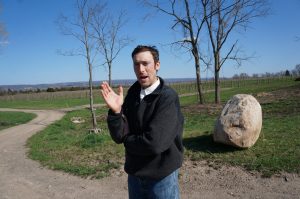
Wiemer released his first wine in 1979, a dry Riesling that received favorable comments in The New York Times. But an intense chill struck at the end of 1980, with temperatures falling to -26 °C. Known locally as the ‘Christmas Massacre,’ the cold seriously damaged most vines in the region, including many of Wiemer’s. But, he noticed that one Riesling vineyard 16 kilometers up the road remained almost unaffected. He kept an eye on the property and purchased it in 1989. Studies have confirmed that the microclimate is warmer there than almost any other portion of the Finger Lakes. Today, Wiemer’s successor, Fred Merwath, produces two single-vineyard wines from the property, Josef and Magdalena Vineyard Rieslings, the latter of which was selected by me two years ago as one of the finest wines produced in the United States in the 2010 vintage
Given the potentially extreme cold (another devastating chill hit in 2004), differences in microclimate are important to understand, but so too is the selection of rootstocks and clones that are best suited. When Wiemer, and certainly Frank, started there was little choice: one planted what one could get, either from nurseries or from whatever cuttings one could secure. In the Finger Lakes back then, there wasn’t much. [It is no coincidence a large portion of Wiemer’s business today is a grape nursery he started in 1979].
THE VARIETIES OF THE FUTURE
Producers, however, are still figuring out what might work best in terms of grape variety, too. Gewurztraminer has a presence in the region, as well as Chardonnay and a menagerie of other white grapes, including Austria’s Gruner Veltliner and Georgia’s Rkatsiteli. As John Martini, owner of Anthony Road Wine Company, notes with the enthusiasm of someone fascinated by future possibilities, “We [the Finger Lakes] have only been at it for the past 50 years – or for most, 20 years or less. Riesling might be king today, but maybe in a generation or two, who knows?”
Red vinifera grapes are growing in importance in the region too, but again, the Finger Lakes are at an experimental stage. Cabernet Franc is the most important in terms of plantings, and perhaps quality. Pinot Noir is the region’s second most widely-planted red vinifera grape. It is generally good here and, occasionally, one comes across an especially distinctive one that points to greater potential for the grape. Johannes Reinhardt, Anthony Road’s Franconian-born winemaker speaks of the grape with reverence, but doesn’t make it every year since he is not always happy with the fruit. “We’ll get there, but it takes a lot of work and takes many extra steps to get that delicacy that makes Pinot Noir beloved.” He adds, encouragingly, that one might have said the same thing about Riesling until the 1980s.
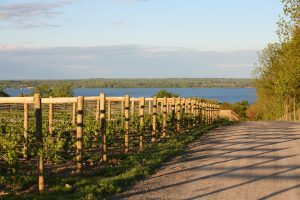
Also prominent is Lemberger, aka Blaufrankisch, which is being produced by increasing numbers of producers and will possibly be a hallmark variety in the region. Fox Run Vineyards has examples going back to the 1990s that have aged beautifully. Though there is less of a track record, other cool climate reds such as northern Italy’s Lagrein and Teroldego, Germany’s Dornfelder and Georgia’s Saperavi show potential, too. Wines made by Mike Schnelle and Nancy Irelan at Red Tail Ridge Winery are especially promising. Examples of varieties that favor warmer climes such as Syrah, Sangiovese and Cabernet Sauvignon are less convincing. Hopefully, this increasing attention will tempt greater numbers of Finger Lakes wineries to focus on quality and precision. Fortunately, there are still plenty of Finger Lakes wines to enjoy in the meantime.



